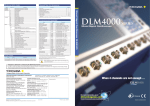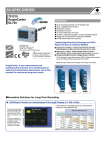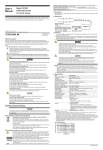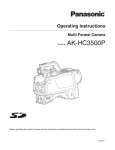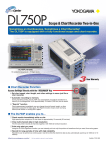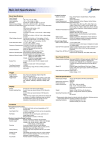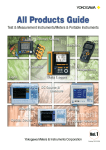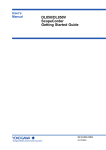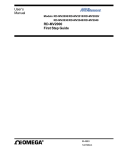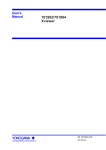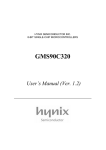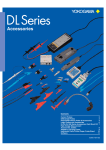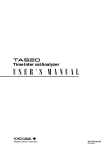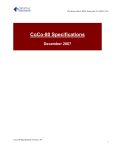Download DL7440/DL7480 Digital Oscilloscope User`s Manual
Transcript
Chapter 17 Specifications 17.1 Input Section Item Specifications Number of input channels DL7440 (4-channel model, models 7071450 and 701460): 4 (CH1 to CH4) DL7480 (8-channel model, models 7071470 and 701480): 8 (CH1 to CH8/4) Input coupling AC 1MΩ, DC 1MΩ, DC 50Ω, and GND Input connector BNC connector Input impedance 1 MΩ±1.0%, approx. 20 pF 50 Ω±1.0% (VSWR 1.4 or less (DC to 500 MHz)) Voltage-axis sensitivity setting For 1MΩ input: For 50 Ω input: Maximum input voltage For 1 MΩ input (at a frequency of 1 kHz or less): 400 V (DC+ACpeak) (282 Vrms CAT II) For 50 Ω input: 5 Vrms and 10 Vpeak (not to exceed either of the two values) Maximum DC offset setting range (When the probe attenuation is set to 1:1) 2 mV/div to 50 mV/div: ±1 V 100 mV/div to 500 mV/div: ±10 V 1 V/div to 10 V/div: ±100 V Vertical (voltage) axis accuracy DC accuracy1: Offset voltage axis accuracy1 2 mV/div to 10 V/div (1-2-5 steps) 2 mV/div to 1 V/div (1-2-5 steps) ±(1.5% of 8 div + offset voltage axis accuracy) 2 mV/div to 50 mV/div: ±(1% of the setting + 0.2 mV) 100 mV/div to 500 mV/div: ±(1% of the setting + 2 mV) 1 V/div to 10 V/div: ±(1% of the setting + 20 mV) Frequency characteristics1, 2 (–3 dB point when a sine wave of amplitude ±4 divisions is input) For 50 Ω input 1 V/div to 10 mV/div: DC to 500 MHz 5 mV/div to 2 mV/div: DC to 400 MHz For 1 MΩ input (when using the 700988 passive probe, indicates the frequency of the input signal at the probe tip) 10 V/div to 10 mV/div: DC to 400 MHz 5 mV/div to 2 mV/div: DC to 300 MHz Lower –3 dB point when AC coupled 10 Hz or less (1 Hz or less when using the 10:1 probe provided) Skew between channels (When using the same settings) 1 ns or less Residual noise level3 ±1.25 mV or ±0.15 div, whichever is greater (typical value4) Isolation between channels (Same voltage sensitivity) At 500 MHz: –34 dB (typical value4) A/D conversion resolution 8 bits (24 LSB/div) Probe attenuation setting 1:1, 10:1, 100:1, 1000:1, 10A:1V5, and 100A:1V5 Bandwidth limit Turn ON/OFF the 100-MHz or 20-MHz bandwidth limit for each channel. Maximum sample rate Realtime sampling mode When interleave mode is ON: When interleave mode is OFF: Repetitive sampling mode: Maximum record length 2 3 4 5 4 MW memory model (701450 and 701470) When interleave mode is ON: 4 MW/CH When interleave mode is OFF: 2 MW/CH 16 MW memory model (701460 and 701480) When interleave mode is ON: 16 MW/CH When interleave mode is OFF: 8 MW/CH Value measured under standard operating conditions (see section 17.12) after warm-up and after calibration with the time base set to internal clock. Value in the case of a repetitive phenomenon. The frequency bandwidth of a single-shot phenomenon is the smaller of the two values, DC to sampling frequency/2.5 and the frequency bandwidth of a repetitive phenomenon. When the input section is shorted, the record length set to 10 kW, the acquisition mode set to normal mode, the accumulation set to OFF, and the probe attenuation set to 1:1. Typical value represents a typical or average value. It is not strictly warranted. Automatically set to the optimum values for the current probe (700937, 701930, or 701931, sold separately). IM 701450-01E 17-1 Specifications 1 2 GS/s 1 GS/s 100 GS/s 17 17.2 Logic Input Section (Optional) Item Specifications 7019801/701981 (8-bit input) Probes that can be used 2 Maximum toggle frequency When using the 701980: 100 MHz, when using the 701981: 250 MHz Number of inputs 16 (when two logic probes are used) Maximum input voltage ±40 V (DC+ACpeak) or 28 Vrms when the frequency is 1 kHz or less. Input range ±10 V Maximum sample rate When interleave mode is ON: 2 GS/s When interleave mode is OFF: 1 GS/s Threshold level When using the 701980: ±40 V (resolution: 0.1 V) When using the 701981: ±10 V (resolution: 0.1 V) ±(0.1 V + 3% of the setting) Threshold accuracy2 Minimum input voltage 2 500 mVp-p Input impedance When using the 701980: Approx 1 MΩ/approx. 10 pF When using the 701981: Approx. 10 kΩ, approx. 9 pF Preset threshold levels CMOS (5 V): 2.5 V, CMOS (3.3 V): 1.6 V, and ECL: –1.3 V 1 2 The 701980 can be used only when the firmware version of the DL7400 is 1.30 or later. Under standard operating conditions (see section 17.12) after the warm-up. 17.3 Trigger Section Item Specifications Trigger mode Auto, auto-level, normal, single, and single(N) Trigger source CH1 to CH8/41 (signal input from each input terminal), LINE (commercial power supply signal that is connected), EXT (signal input from the EXT TRIG IN terminal) Trigger coupling CH1 to CH8/41: EXT: HF rejection Select the bandwidth limit with respect to the trigger source (OFF, DC to approx. 15 kHz, or DC to approx. 20 MHz) for each channel (CH1 to CH8/41) Trigger hysteresis Select high or low for the trigger level hysteresis width for each channel (CH1 to CH8/41) Trigger level range CH1 to CH8/41: EXT: ±4 divisions from the screen center (resolution of 0.01 divisions) ±2 V (resolution is 5 mV) Trigger level accuracy CH1 to CH8/41, 2: EXT3: ±(1 division + 10% of the trigger level) ±(50 mV + 10% of the trigger level) Probe attenuation setting for external trigger 1:1 or 10:1 Trigger sensitivity3 CH1 to CH8/41: EXT: DC/AC DC 1 divP-P at DC to 500 MHz 100 mVP-P at DC to 100 MHz Trigger position Can be set in 1% increments of the display record length. Trigger delay range 0 to 4 s Hold off time range 80 ns to 10 s Trigger slope Rising, falling, rising and falling (for edge trigger) 17-2 IM 701450-01E 17.3 Trigger Section Item Specifications Trigger type Edge: A->B(N): Trigger gate Trigger can be activated only when the trigger condition is met when the input from the trigger gate input terminal (TRIG GATE IN) is active. Active level can be set to high or low. Specifications 1 2 3 4 5 Activate the trigger on the edge of a single trigger source. Trigger occurs nth time condition B becomes true after condition A becomes true. Count: 1 to 108 Condition A: Enter/Exit Condition B: Enter/Exit A Delay B: Trigger occurs first time condition B becomes true after specified delay following condition A true. Specified time: 3 ns to 5 s Condition A: Enter/Exit Condition B: Enter/Exit OR: Trigger occurs on the OR logic of the trigger conditions set to multiple trigger sources. Trigger condition is edge or window. Rise (IN), Fall (Out), or Don’t Care can be set to each channel CH1 to CH8/41. Pattern: Trigger occurs on the edge of the clock channel with respect to the True/False condition of the parallel pattern set to multiple trigger sources. If the clock channel is set to Don’t Care, trigger occurs on the Enter or Exit condition of the True/False condition of the parallel pattern. Parallel pattern is the AND of the channels. Width: Trigger occurs on the True/False width of the parallel pattern of multiple trigger sources. Parallel pattern is the AND of the statuses of the channels or the AND of the window conditions of the channels. Pulse<Time: Trigger occurs when the width described above is smaller than Time. Pulse>Time: Trigger occurs when the width described above is greater than Time. T1<Pulse<T2: Trigger occurs when the width described above is greater than T1 and smaller than T2. Time Out: Trigger occurs when the width described exceeds Time. Specified time: 1 ns to 1 s ±(0.5% of the setting4 + 1 ns) Time accuracy2: Minimum time detection width2: 2 ns (typical value5) TV: Activates a trigger on the video signal of various formats: NTSC, PAL, SECAM, 1080/60i, 1080/50i, 720/60p, 480/60p, 1080/25p, 1080/24p, 1080/ 24sF, and 1080/60p CH1 is the only input channel. Field number and line number selectable. Logic: Trigger occurs on the edge of the clock bit with respect to the True/False condition of the parallel pattern of multiple logic inputs. If the clock bit is set to Don’t Care, trigger occurs on the Enter or Exit condition of the True/False condition of the parallel pattern. Parallel pattern is the AND of the statuses of the bits of Pod A and B (16 bits) Clock bit is an arbitrary bit of Pod A and B (16 bits). • Condition A and Condition B are parallel patterns set using High, Low, and Don’t Care on each channel CH1 to CH8/41. The maximum number of channels varies depending on the model. Under standard operating conditions (see section 17.12) after the warm-up and calibration. Under standard operating conditions (see section 17.12) after the warm-up. The value of T2 for T1<Pulse<T2. Typical value represents a typical or average value. It is not strictly warranted. 17 IM 701450-01E 17-3 17.4 Time Axis Item Specifications Time axis range 1 ns/div to 50 s/div (when the record length is greater than or equal to 10 kW) 1 ns/div to 5 s/div (when the record length is equal to 1 kW) Time base accuracy1 ±(0.005%) Time axis precision1 ±(0.005% + 50 ps + 1 digit)2 External clock input (EXT CLOCK IN) Connector type Maximum input voltage Input frequency range Sampling jitter Minimum input amplitude Threshold level Input impedance Minimum pulse width 1 2 BNC ±40 V (DC+ACpeak) or 28 Vrms when the frequency is 10 kHz or less. 40 Hz to 20 MHz (continuous clock only) ±1.25 ns or less 0.1 VP-P ±2 V (resolution is 5 mV) Approx. 1 MΩ and 22 pF 10 ns or more for high and low. Under standard operating conditions (see section 17.12) after the warm-up. 1 digit is the amount of time that cannot be determined due to sampling error. 17.5 Display Item Specifications Display 8.4" color TFT LCD monitor Display screen size 170.9 mm (width) × 129.6 mm (height) Total number of pixels* 640×480 Display resolution of the waveform display 500×384 * Liquid crystal display may include few defective pixels (within 20 ppm with respect to the total number of pixels including RGB). There may be few pixels on the liquid crystal display that do not turn ON all the time or remains ON all the time. Note that these are not malfunctions. 17.6 Function Acquisition and Display Item Specifications Acquisition mode Select from 4 acquisition modes: normal, envelope, averaging, and box average. Sampling mode Switch between realtime sampling and repetitive sampling at some of the time axis settings. Record length 1 kW, 10 kW, 50 kW, 100 kW, 250 kW, 500 kW, 1 MW, 2 MW, 4 MW, 8 MW, and 16 MW (8 MW and 16 MW are available only on the 16 MW memory model.) Zoom Expand the displayed waveform along the time axis (up two locations using separate zoom rates) Display format Split display of analog waveforms (1, 2, 3, 4, 6, and 8 windows (1, 2, 3, 4, and 6 windows on the 4-channel model) and a logic window for logic waveforms (optional). Display interpolation Select interpolation OFF (dot display of sample points), sine interpolation display, linear interpolation display, or pulse interpolation display. Graticule Select from three graticule types. Auxiliary display ON/OFF Turn ON/OFF the scaled values and waveform labels. X-Y display Displays two X-Y waveforms of XY1 and XY2. Accumulation Accumulates waveforms on the display. Select persistence mode or color grade mode. Snapshot Retains the current displayed waveform on the screen. Snapshot waveforms can be saved and loaded. Clearing traces Clears the displayed waveform. 17-4 IM 701450-01E 17.6 Function Vertical and Horizontal Axes Item Specifications Channel ON/OFF ON/OFF on each channel CH1 to CH8/4* Input filter Set 100-MHz or 20-MHz bandwidth limit on each channel CH1 to CH8/4*. Vertical position Waveforms can be moved vertically in the range of ±4 div from the center of the waveform display frame. Linear scaling Set the scaling factor, offset value, and unit on each channel CH1 to CH8/4*. Roll mode Roll mode display is enabled when the trigger mode is set to auto, auto level, or single at the following time axis settings. 1 MW or less: 50 ms/div to 50 s/div (except 50 ms to 5 s/div for 1kW) 2 MW: 100 ms/div to 50 s/div 4 MW: 200 ms/div to 50 s/div 8 MW: 500 ms/div to 50 s/div 16 MW: 1 s/div to 50 s/div * The maximum number of channels varies depending on the model. Computation, Analysis, and Search Item Specifications Computation +, –, ×, binary computation, invert, differentiation, integration, and power spectrum. The maximum record length that can be computed is as follows: 4 MW memory model (701450 and 701470): All record lengths. 16 MW memory model (701460 and 701480): 8 MW when interleave mode is ON 4 MW when interleave mode is OFF However, select the range (1 kW or 10 kW) for power spectrum computation (FFT). Phase shift Waveforms can be observed by shifting the phase of CH1 to CH8/41. Computation is performed using the phase-shifted waveforms. The maximum record length that can be phase shifted is 8 MW. User-defined computation Equations obtained by arbitrarily combining the following operators. (optional) +, –, ×, /, ABS, SQRT, LOG, EXP, NEG, SIN, COS, TAN, ATAN, PH, DIF, DDIF, INTG, IINTG, BIN, P2, P3, F1, F2, FV, PWHH, PWHL, PWLH, PWLL, PWXX, DUTYH, DUTYL, FILT1, FILT2, HLBT, MEAN, LS-, PS-, PSD-, CS-, TF-, CH-, MAG , LOGMAG, PHASE, REAL, and IMAG The maximum record length is the same as the normal computation shown above. However, computation is performed on up to 2 MW from the computation start point. Search for and display waveforms from the history memory that meet specified conditions. Select the search method from the following two types. Zone: Set an area on the screen, then extract and display only those waveforms that pass through the area (Pass mode), or do not pass through the area (Bypass mode). Parameter: Extract and display only the results of the automated measurement of waveform parameters that meet the specified condition. Search & zoom Search a section of the displayed waveform data and display the section expanded. Select the search method from the following five types. Edge: Counts the rising and falling edges and automatically searches an arbitrary edge. Serial pattern: Automatically searches serial patterns of up to 64 bits synchronized or not synchronized to the clock. Parallel pattern: Automatically searches parallel patterns of CH1 to CH8/41, MATH1, MATH2, and 16 bits of logic (optional). Pulse width: Automatically searches the locations where the pulse width meets the specified condition. Auto scroll: The zoom position can be automatically scrolled. Cursor measurements The following cursors are selectable. Horizontal, Vertical, Marker, and Degree Automated measurement of waveform parameters Capable of performing automated measurement of waveform parameters. Automated measurement of waveform parameters within one cycle (P-P through Int2XY), statistical processing of waveform parameters, and statistical processing on the waveform parameters of historical data. P-P, Max, Min, Avg, Rms, Sdev, High, Low, +OShot, –OShot, Int1TY, Int2TY, Int1XY, Int2XY, Freq, Period, Rise, Fall, +Width, –Width, Duty, Burst1, Burst2, Pulse, AvgFreq, AvgPeriod, and Delay (between channels) Statistical processing results Statistics: Min, Max, Avg, Cnt, and Sdv Measurement of waveform parameters in dual areas is also possible. Computation can be performed between waveform parameters measured in dual areas and constants. Operators are +, -, *, and /. GO/NO-GO determination The following two types of GO/NO-GO determination are available • Determination using zones on the screen • Determination using the result of the automated measurement of waveform parameters Specify an action for NO-GO result. Possible actions are screen image data output, waveform data storage, buzzer notification, and e-mail transmission2. IM 701450-01E 17-5 Specifications History search 17 17.6 Function Item Specifications SPI signal analysis/search Data analysis and search by applying Clock to CH1, Data1 to CH2, Data2 to CH3, and CS signals to CH4 to CH81 or bit 0 to bit 7 of logic input (optional) Pod A. Analysis function: Display the status of Data1, Data2, and CS in unit of bytes (8 bits) of serial data. The analysis results can be output to a file. Search function: Search arbitrary or specific data patterns based on the analysis results. 1 2 The maximum number of channels varies depending on the model. When the Ethernet interface option is installed. Saving and Printing of the Screen Image Data Item Specifications Built-in printer (optional) Prints screen image data. External printer Outputs the screen image to an external printer via the USB PERIPHERAL terminal or the Ethernet network1. Supports page description languages and printer types such as ESC/P, ESC/P2, LIPS3, PCL5, Post Script (only via the Ethernet network1), and BJ Floppy disk or Zip disk2, SCSI3, network drive1, and PC card Output data format: PostScript, TIFF, BMP, JPEG, and PNG 1 2 3 When the Ethernet interface option is installed. Select the floppy disk drive or Zip drive for the built-in storage medium drive at the time of purchase. When the SCSI option is installed. Data Storage Item Specifications History memory When interleave mode is ON: Automatically save up to 4096 acquisition data points. When interleave mode is OFF: Automatically save up to 2048 acquisition data points. Floppy disk or Zip disk1, SCSI2, network drive3, and PC card Saves setup data, waveform data, and various data 1 2 3 Select the floppy disk drive or Zip drive for the built-in storage medium drive at the time of purchase. When the SCSI option is installed. When the Ethernet interface option is installed. Other Functions Item Specifications Initialization Resets settings to the factory default (excluding date/time setting, communication interface settings, SCSI ID number setting, settings stored to the internal memory using the store/ recall function, and language setting) Auto setup Automatically set the optimum voltage axis, time axis, trigger, and other settings for the input signal. Store/Recall Store to and recall from the DL7400 internal memory up to three sets of arbitrary setup data. Preset Presets for CMOS (5 V), CMOS (3.3 V), ECL, and user settings. Action-on-trigger Output screen image data, saves waveform data, activates buzzer notification, or sends email messages each time a trigger occurs. Mail transmission1 Periodically send the status of the DL7400 to a specified mail address via the Ethernet network. Can also send information as an action for GO/NO-GO determination and actionon-trigger. Calibration Auto calibration and manual calibration available. Deskew Correct the delay of the acquired waveforms on each channel. Adjustment range is ±100 ns (0.01 ns resolution) Environment settings Set the screen color, date/time, message language, and click sound ON/OFF Probe compensation signal output Outputs a signal (rectangular signal of approx. 1 Vp-p and approx. 1 kHz) from the probe compensation output terminal on the front panel Overview Check the system status of the DL7400. Self test Memory test, key test, printer test, FDD/Zip drive2 test, SCSI test, and accuracy test are possible. Help Displays help concerning the settings (select English or Japanese) Thumbnail Shows thumbnails of the screen image data 1 2 17-6 When the Ethernet interface option is installed Select the floppy disk drive or Zip drive for the built-in storage medium drive at the time of purchase. IM 701450-01E 17.7 Built-in Printer (Optional) Item Specifications Printing system Thermal line dot system Dot density 8 dots/mm Paper width 112 mm 17.8 Storage Built-in Floppy Disk Drive* Item Specifications Number of drives 1 Size 3.5 inch Capacity 1.44 MB * Select the floppy disk drive or Zip drive for the built-in storage medium drive at the time of purchase. Built-in Zip Drive* Item Specifications Number of drives 1 Capacity 100 MB or 250 MB * Select the floppy disk drive or Zip drive for the built-in storage medium drive at the time of purchase. SCSI (Optional) Item Specifications Standard Conforms to ANSIX3.131-1986 for SCSI (Small Computer System Interface) Connector Half pitch 50 pins Connector pin assignment Unbalanced (single-ended) PC Card Interface Item Specifications Number of slots 1 Supported cards Flash ATA memory card (PC card TYPE II) 17.9 Keyboard, Printer, and Mouse Interfaces Specifications Item Specifications Connector type USB type A connector (receptacle) Electrical and mechanical specifications Conforms to USB Revision 1.0 Supported keyboards 104 keyboard (US), 109 keyboard (Japanese), and 89 keyboard (US and Japanese) conforming to USB HID Class Version 1.1 Supported printers ESC/P, ESC/P2, LIPS3, PCL5, and BJ (can be used on models that support the BJC-35V native commands) that support USB (USB Printer Class Version 1.0) Supported mouse Mouse conforming to USB HID Class Version 1.1 Power supply 5 V, 500 mA (per port) Number of ports 2 IM 701450-01E 17-7 17 17.10 Auxiliary I/O Section External Trigger Input1 and Trigger Gate Input1 Item Specifications Connector type Input bandwidth BNC 2 DC to 100 MHz3 Input impedance Approx. 1 MΩ and 22 pF Maximum input voltage ±40 V (DC+ACpeak) or 28 Vrms when the frequency is 10 kHz or less. Trigger level ±2 V (resolution of 5 mV) 1 2 3 The external trigger input terminal (EXT TRIG IN)/trigger gate input terminal (TRIG GATE IN) is also used as an external clock input terminal (EXT CLOCK IN). See the specifications of the external clock input (see section 17.4). Under standard operating conditions (see section 17.12) after the warm-up. The input frequency range when using the terminal as a trigger gate input is DC to 50 MHz. Trigger Output (TRIG OUT) Item Specifications Connector type BNC Output level TTL Output logic (Negative) Output delay time 50 ns max Output hold time 1 µs minimum for low level and 100 ns minimum for high level RGB Video Signal Output (VIDEO OUT) Item Specifications Connector type 15-pin D-Sub receptacle Output type VGA compatible Probe Power Supply Terminal Item Specifications Number of output terminals 4 (A to D) (4 optional terminals (E to H) can be added on the 8-channel model). Output voltage +12 V (Up to ±500 mA on each pair of terminals A and E; B and F; C and G; and D and H.) Probes that can be used FET probe (700939), current probe (700937, 701930, or 701931), and differential probe (701920 or 701922) 17-8 IM 701450-01E 17.11 Computer Interface GP-IB Item Specifications Electrical and mechanical specifications Conforms to IEEE St’d 488-1978 (JIS C 1901-1987). Functional specifications SH1, AH1, T5, L4, SR1, RL1, PP0, DC1, DT0, and C0 Protocol Conforms to IEEE St’d 488.2-1987. Code ISO (ASCII) code Mode Addressable mode Address Specify a talker/listener address between 0 and 30. Clear remote mode Remote mode can be cleared using the SHIFT+CLEAR key (except during Local Lockout). USB Item Specifications Connector type USB type B connector (receptacle) Electrical and mechanical specifications Conforms to USB Revision 1.0. Data rate 12 Mbps max. Number of ports 1 PC system supported PC running Windows 98 SE, Windows Me, Windows 2000, or Windows XP with a standard USB port (a separate driver is needed to connect to a PC). Ethernet (Optional) Item Specifications Number of communication ports 1 Electrical and mechanical specifications Conforms to IEEE802.3. Transmission system Ethernet (100BASE-TX/10BASE-T) Transmission rate 100 Mbps max. Communication protocol TCP/IP Supported services FTP server, FTP client (network drive), LPR client (network printer), SMTP client (mail transmission), Web server, DHCP, DNS, SNTP*, and WebDAV* Connector type RJ-45 connector * SNTP and WebDAV are available only on models with a firmware version of 1.30 or later. Specifications 17 IM 701450-01E 17-9 17.12 General Specifications Item Specifications Standard operating conditions Ambient temperature: 23±2°C Ambient humidity: 55±10% RH Error in supply voltage and frequency: Warm-up time At least 30 minutes Storage conditions Temperature: Humidity: –20 to 60°C, –20 to 50°C (for the -J2: built-in Zip drive model) 20 to 80% RH (no condensation) Operating Conditions Temperature: Humidity: 5 to 40°C 20 to 80% RH (when the printer is not used) (no condensation) 35 to 80% RH (when the printer is used) (no condensation) Storage altitude 3000 m or less Operating altitude 2000 m or less Rated supply voltage 100 to 120 VAC/220 to 240 VAC Within 1% of rating Permitted supply voltage range 90 to 132 VAC/198 to 264 VAC Rated supply voltage frequency 50/60 Hz Permitted supply voltage frequency range 48 to 63 Hz Power fuse 250 V/6.3 A time lag, VDE/SEMKO/UL/CSA certified. Inside the case. Cannot be replaced by the user. Maximum power consumption 320 VA Withstanding voltage 1.5 kVAC for one minute. (between power supply and case) Insulation resistance 10 MΩ or more at 500 VDC. (between power supply and case) External dimensions (details on the next page) 373 mm (W) × 210.5 mm (H) × 355.3 mm (D) (When the printer cover is closed. Excludes the handle and other projections.) Weight Approx. 10 kg (only the main unit without the printer) Instrument’s cooling method Forced air cooling, exhaust from rear. Installation position Horizontal (the stand can be used to tilt the DL7400), stacking prohibited. Recommended calibration period 1 year Battery backup Setup data and clock are backed up with the internal lithium battery Battery life: Approx. 5 years (at ambient temperature of 23°C) Standard accessories • • • • • • • • • • 17-10 Power Cord: 400 MHz passive probe: Soft case: Front panel protection cover: Printer roll paper: Rubber feet: User’s manual: Operation guide: Communication Interface User’s Manual: Power Supply Analysis Function User’s Manual: 1 piece 4 pieces B9969ET, 1 piece B8051DP, 1 piece 1 roll (for /B5 suffix code) 4 pieces (2 A9088ZM) 1 piece 1 piece 1 piece (CD-ROM) 1 piece (for /G4 suffix code) IM 701450-01E 17.12 General Specifications Item Specifications Safety Standards Complying standards EN61010-1 • Overvoltage category II1 • Pollution degree 22 Emission Complying standards • • • • Cable condition • • • • • • • • • Immunity 2 3 4 • EN61326 commercial environment (applies to 701450, 701460, 701470, 701480, 700988, 700939, and 701981) Influence in the immunity environment • Noise increase: ≤ ±200 mV (when using 700988) ≤ ±400 mV (when using 700939) No influence (when using 701981) • Test conditions When using the 700988: 1 GS/s, envelope mode, 20 MHz BWL, 1 MΩ input coupling, 50 mV/div (10:1 probe attenuation setting), and 50-Ω termination at the probe tip. When using the 700939: 1 GS/s, envelope mode, 20 MHz BWL, 50 Ω input coupling, 100 mV/div (10:1 probe attenuation setting), 50-Ω termination at the probe tip, and with a ferrite core (TDK: ZCAT2035-0930A, YOKOGAWA: A1190MN) attached to each end of the signal cable. When using the 701981: 1 GS/s, envelope mode, and 50-Ω termination at the probe tip. • Cable condition Same as the cable condition for emission above. The Overvoltage Category (Installation Category) is a value used to define the transient overvoltage condition and includes the impulse withstand voltage regulation. II applies to electrical equipment that is powered by a fixed installation such as a distribution board. Pollution Degree applies to the degree of adhesion of a solid, liquid, or gas which deteriorates withstand voltage or surface resistivity. Pollution Degree 2 applies to normal indoor atmospheres (with only non-conductive pollution). Use cables of length 3 m or less. Use cables of length 30 m or less. IM 701450-01E 17-11 Specifications 1 Complying standards EN61326 Class A, C-Tick AS/NZS 2064 (applies to 701450, 701460, 701470, 701480, 700988, 700939, and 701981) EN61000-3-2 EN61000-3-3 This product is a Class A (for commercial environment) product. Operation of this product in a residential area may cause radio interference in which case the user is required to correct the interference. External trigger input/external clock input/trigger gate input terminal Use a BNC cable3 and attach a ferrite core (TDK: ZCAT2035-0930A, YOKOGAWA: A1190MN) on one end (DL7400 end). Trigger output terminal Same as the external trigger input terminal above. RGB video signal output (VIDEO OUT) terminal Use a 15-pin D-Sub VGA shielded cable3. SCSI connector Use a SCSI shielded cable3 and attach a ferrite core (TDK: ZCAT20350930A, YOKOGAWA: A1190MN) on one end (DL7400 end). USB PERIPHERAL connector Attach a ferrite core (TDK: ZCAT1325-0530A, YOKOGAWA: A1181MN) on one end (DL7400 end) of the USB cable3. USB interface connector Attach a ferrite core (TDK: ZCAT1325-0530A, YOKOGAWA: A1181MN) on one end (DL7400 end) of the USB cable3. Ethernet interface connector Use a Ethernet interface cable4 and attach a ferrite core (TDK: ZCAT2035-0930A, YOKOGAWA: A1190MN) on one end (DL7400 end). Probe power terminal Attach a ferrite core (TDK: ZCAT1325-0530A, YOKOGAWA: A1181MN) on one end (DL7400 end) of the cable. Logic probe input connector Attach a ferrite core (TDK: ZCAT2035-0930A, YOKOGAWA: A1190MN) on one end (DL7400 end) of the cable. 17 17.13 External Dimensions Unit: mm Rear View A B C D E F G H 100-120/220-240V AC 320VA MAX 50/60Hz ETHERNET ACT VIDEO OUT GP-IB(IEEE488) 100BASE-TX SCSI PROBE POWER USB LINK A (VGA) B USB PERIPHERAL WARNING LOGIC PROBE Do not operate within reading safety precautions in user s manual. TRIG OUT EXT CLOCK IN EXT TRIG IN TRIG GATE IN <40Vpk 1MΩ 14 40 31 349.6 324.3 20 210.5 374 373 If not specified, the tolerance is ±3%. However, in cases of less than 10 mm, the tolerance is ±0.3 mm. 17-12 IM 701450-01E












